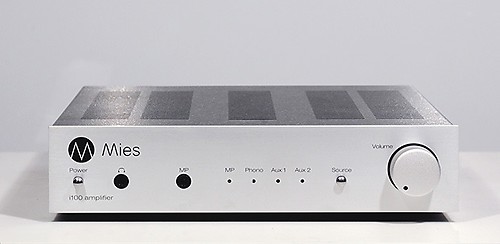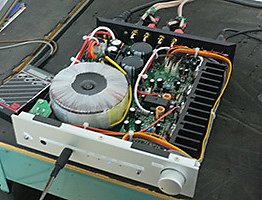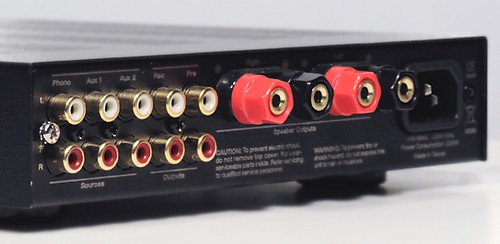Gunnar van Vliet on the Mies i100 integrated amplifier
Following not-all-that-far on the heels of my earlier interviews with KickStarter candidates Jim Hagerman (Hagerman Technology Bugle 2) and Gavin Fish (Light Harmonic Geek DAC), I received a note from Gunnar van Vliet of Planet of Sound asking me if I’d be interested in doing something on a KickStarter campaign he had just launched. Billed as “The Ultimate Amplifier for Vinyl Lovers”, this compact integrated amplifier is scheduled to retail for an undeniably affordable $399 CAD, with the first 50 KickStarter backers to get one for only $299 CAD.
My first reaction: Yikes! Give me some time… Second reaction: Hey, what is this anyway, it looks pretty interesting…. Third reaction: well, HifiZine has just switched to a “publish when ready” model… So, I asked Gunnar if he’d be willing to do a quick turnaround on a set of interview questions for our Industry Spotlight….

JR: Gunnar, thank you for speaking with HifiZine! How did you get started in Hifi? From the very beginning…
GvV: My earliest memories of hifi were of listening to components with my dad. We lived in a very rural area and didn’t even have electricity. The stereo was powered by a windmill and inverter! Nightly listening sessions established the audiophile bug pretty early on. Later, I ran a large record store, started selling turntables and then amps etc. It all grew from there into Planet of Sound. Planet of Sound turns 8 this year.
JR: Tell us about the transition from “dealer” to “manufacturer” – are there any interesting insights you could provide into this dual role?
GvV: The dealer landscape is very established so starting as a new independent was very tough. No supplier wanted to risk existing business to take a chance on a new guy. We fought hard from the beginning to find alternative products that were superior sounding and we are extremely loyal to those generous suppliers still. As we grew, we found we had to start importing products ourself because we couldn’t find the quality we wanted locally in all cases. Now we supply to other stores such as ours. That has been a very rewarding feeling. We have a large enough market presence and reputation to be attracting people well outside of the traditional audiophile realm and we’re finding that certain products people want really don’t exist anywhere. It’s a huge advantage to be a retailer talking to customers every day and hearing what they want. Tip toeing into manufacturing has allowed us to remain competitive and to complement our existing legacy partners so we can offer an extremely well-rounded service to customers. We don’t have any desire to compete with our already superb suppliers in the majority of product categories. This is about filling certain niches where we have high demand but no products to sell.
JR: Your manufactured products are released under the brand “Mies.” What’s the origin of the name?
GvV: I’m a big fan of the minimalist aesthetic as well as engineering that is extremely functional. Mies van der Rohe is an inspiration.
JR: The KickStarter campaign is not very informative to those who might be seeking the typical electronic “specifications”. Tell us why?
GvV: If you spend any time on internet audio forums you’ll find a prevalence in arguing over which product is better based on specifications. People are quick to bash products they’ve never heard based on something as trivial as one having less watts or lacking this or that compared to another product. The negative always seems to outweigh the positive. We do believe in specifications, but we don’t want to take the focus away from the basic purpose of the amp which is to make a very small, phono-friendly amp that can drive just about any speaker and do it cheaply. We’ve taken care of the sound quality for sure. After the introductory production run is made, we’ll be happy to submit it for reviews and people can debate the intricate specs etc.
JR: How would you compare the sound of the i100 with other compact (or not) integrated amplifiers? Is it, say, a Brio for a lot less money? Or…?
GvV: I’ve heard at least 1000 amplifiers and something like the Brio is an amp that I respect because it is simple and ergonomically well designed, and it sounds good. I don’t tend to make public comparisons between our product and specific others, but I can tell you that I’m not the type of person to carry any product unless the performance is special.
JR: From the heat sink apparent in the photos, it looks like the i100 is NOT a Class D power amplification stage? Tell us about your design choices here.

GvV: Yes, this is a Class A/B design. Sounds very linear with a sweet and highly resolved treble. 42 Wpc into 8 ohms, 70 into 4. It’s a hefty transformer and a very good layout.
JR: Do you have any recommendations for cartridges or turntable/cartridge combos that match well with the i100?
GvV: It works exceptionally well with any MM cartridge. We tried it with various Grado and Ortofons. I’d have no problem using up to an Ortofon 2M Black or even some of the high output MC cartridges. In my house I’d be happy using up to a $1000 turntable with the i100.
JR: The i100 has a stereo 3.5mm jack on the front for “iphones”. Did you get any feedback during development about adding a USB input?
GvV: We’re really looking at the average person buying this amp and generally an RCA to 3.5mm cable from a laptop will sound spectacular through the i100, or indeed a simple 3.5mm to 3.5mm cable to the music player input on the front. The amp itself and the speaker is much more important than the quality a USB input would add for the typical buyer’s system. Practically, it also allowed us to meet a “mass-market” price point and to keep the chassis absolutely as small as possible. Adding a USB input would have been impossible at this size. If we are successful, certainly there could be an add on USB DAC for more sophisticated listeners.

JR: In the KickStarter campaign, the first 50 backers get a nice discount off the RRP. Any concern that after the first 50, potential backers might wait for reviews to come out rather than backing the campaign? Please share with us your reasoning on the campaign pricing strategy.
GvV: At $299 including shipping we really aren’t making any money on these first 50 given the component and design costs. It’s a means of building excitement and getting the project off to a quick start. Even at $399, this is still one of the best sounding amplifiers I’ve heard under $1000 so we hope that people will respond and show their support.
JR: Excellent! So, getting back to the fundamental “why” of all this: what’s spinning this week in your system?
GvV: We’ve got Paul McCartney’s album New on regular rotation. Pretty rockin’ album from an old fogey. I also really like Bill Callahan’s Dream River. It’s a stunning sounding record and I think he is currently America’s greatest folk singer.
JR: Gunnar, thank you.
GvV: Thank you very much John!




In the process of troubleshooting the i100. Only stereo left side comes through, earphones also. The signal is present at the base and emitter of the power transistors. I can’t go no further because I have no schematic. I would appreciate if you could send me one.